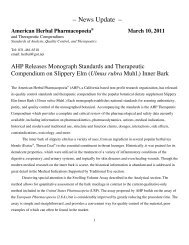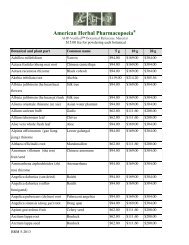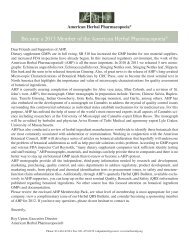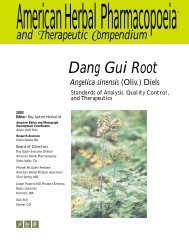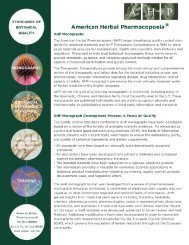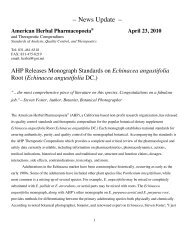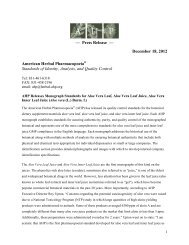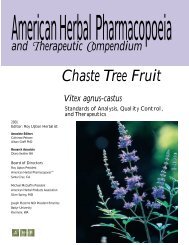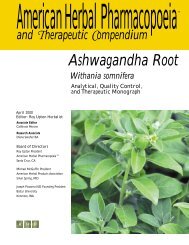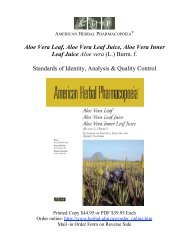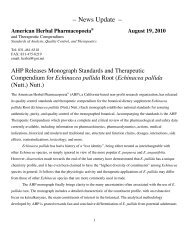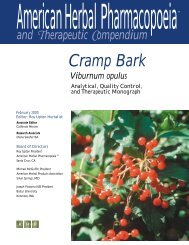alerian oot - American Herbal Pharmacopoeia
alerian oot - American Herbal Pharmacopoeia
alerian oot - American Herbal Pharmacopoeia
You also want an ePaper? Increase the reach of your titles
YUMPU automatically turns print PDFs into web optimized ePapers that Google loves.
Foreign Organic Matter:<br />
Total Ash:<br />
Acid Insoluble Ash:<br />
Loss of Moisture on Drying:<br />
Extractable Matter:<br />
Microbial Contamination:<br />
Qualitative Standards<br />
Not more than 5% stem bases, not more than 2% other foreign matter (European<br />
<strong>Pharmacopoeia</strong> 1998).<br />
Not more than 12% determined on 1 g herb (European <strong>Pharmacopoeia</strong> 1998).<br />
Not more than 5% determined on 1 g herb (European <strong>Pharmacopoeia</strong> 1998).<br />
Not more than 12% determined on 10.0 g powdered herb (#355) dried at 100 °C to<br />
105 °C for 2 hours (European <strong>Pharmacopoeia</strong> 1998).<br />
Not less than 20%. Mix 2.00 grams of powder (#250) with a mixture of 12 g ethanol<br />
(96%) and 8 g of water. Allow to stand for 2 hours, shaking frequently, filter, evaporate<br />
filtrate to dryness on a water bath, and dry the residue at 100 °C to 105 °C.<br />
The residue should weigh not less than 0.1 g (European <strong>Pharmacopoeia</strong> 1998).<br />
Negative for Salmonella species, Escherichia coli, and Staphylococcus aureus<br />
(Pharmacopeial Forum 1998).<br />
T HERAPEUTICS<br />
Pharmacokinetics<br />
The only pharmacokinetic data available for v<strong>alerian</strong> are regarding the valepotriates.<br />
The clinical relevance of this is largely inconsequential as valepotriates rapidly<br />
degrade in commercial products. Although metabolic by-products of valepotriates are<br />
considered to be more active than the valepotriates themselves, these are similarly not<br />
present in commercial products.<br />
Valepotriates administered orally to mice are reported to be poorly absorbed, having<br />
an efficiency of 0.19% of the administered dose. The greatest quantity of 14 Clabeled<br />
valepotriates were found in the stomach lining and in the intestines, and<br />
unchanged valepotriates were reported in the stomach contents 15 hours after administration.<br />
Small amounts of valepotriates and their decomposition products were<br />
reported to be found in the blood, liver, kidneys, heart, lungs, and brain (Steinegger<br />
and Hänsel 1992). Another study with radioactive didrovaltrate administered to mice<br />
orally, intravenously, and intraduodenally also reported poor absorption in the<br />
unchanged form. However, the researchers found the bulk of the radioactivity in<br />
polymeric degradation products and confirmed a fast degradation or metabolic<br />
decomposition with in vitro studies using plasma and liver homogenates (Wagner and<br />
Jurcic 1980).<br />
Pharmacodynamics<br />
Research into the pharmacological activity of v<strong>alerian</strong> has almost exclusively focused<br />
on its sedative and spasmolytic properties. Individual components have displayed<br />
activity, but no single constituent has been shown to account for v<strong>alerian</strong>’s total<br />
action. Early in the 20th century, it was believed that the essential oil was the component<br />
responsible for the sedative effect of v<strong>alerian</strong> (Houghton 1988). However,<br />
work by Gstirmer and Kind published in 1951 indicated that the essential oil accounted<br />
for only one-third of the sedative activity of the extract (Gstirmer and Kind 1951).<br />
In 1969, Eickstedt and Rahman reported that valepotriate esters isolated from v<strong>alerian</strong><br />
demonstrated sedative activity in mice (Eickstedt and Rahman 1969). However,<br />
Japanese samples of V. officinalis containing low amounts of valepotriates showed a<br />
greater effect on hexobarbital-induced sleeping time than Chinese and Nepalese<br />
samples containing high amounts of valepotriates (Hikino and others 1980). Also,<br />
valepotriates are not water soluble and were excluded as the active hypnotic in an<br />
aqueous extract which was found to be an effective sleep aid in clinical trials<br />
(Leathwood and Chauffard 1985). In addition, an in vivo study measuring cerebral<br />
glucose turnover in rats found that although a dichloromethane extract demonstrated<br />
depressant activity, this activity could not be accounted for by valepotriates,<br />
<strong>American</strong> <strong>Herbal</strong> <strong>Pharmacopoeia</strong> • V<strong>alerian</strong> R<strong>oot</strong> • April 1999 Page 13



